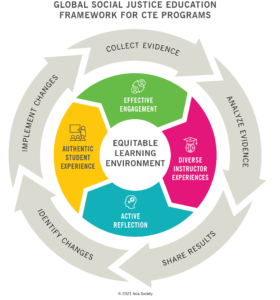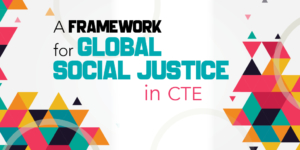“A framework for global social justice in CTE” appears in its entirety in Techniques’ November/December 2021 print issue.
Social justice has become a focus for educators and educational systems around the world. The Center for Global Education at Asia Society has partnered with ACTE to address equity issues for all students in career development and preparation.
We developed a framework to assist educators in reflecting on their students and educational environments. Take a moment to consider your students:
- What cultural experiences do your students bring to your program?
- How well do your students overcome obstacles and find support when they need it?
- What employment experiences do your students bring?
- What opportunities have students already had in your specific career field?
The Global Social Justice Education Framework provides a model to help educators ensure that career and technical education (CTE) programs are designed to value all students and to prepare them for success in our interconnected world.
Global social justice education challenges all educators to utilize global competence as a framework to recognize systems of injustice, and to work to create equitable learning environments for all participants.
CTE educators hold a unique position to help students develop an appreciation for the intersections of work, social justice and the common good. Let’s explore the Global Social Justice Education Framework further, and then we’ll review some resources to help educators.
Global competence and social justice
Global competence is the knowledge, skills, and dispositions to understand and act creatively on issues of global significance. Critical thinking, curiosity and problem-solving skills must be applied to understand the world in its full complexity. It’s important that students understand how local issues affect broader global forces.
Social justice examines how inequality and oppression are constructed in every level of societal organization. At the individual level, this is reflected in attitudes and behaviors; at the institutional level, through policies and practices; and at the societal level, through messages of what is deemed “correct.” Each level interacts with and reinforces the others.
If we explore the social construction and histories of our laws, policies and practices to recognize that what has “always been done” may not always be right, then we can act to change systems that advantage some and disadvantage others.
In CTE, global social justice means:
- Engaging all students in respectful, collaborative experiences that teach learners to value the perspectives of others, including looking to international sources for possible solutions to challenges.
- Creating a program culture and selecting curricular materials that integrate global content and reflect students’ backgrounds and life experiences.
- Providing equal opportunities for participation in internationalized CTE programs, learning activities and work-based learning.
Global social justice education
Global social justice education is driven by reflective practitioners who ally with students to challenge systems of injustice and to inspire hope. There are four dimensions of global social justice education that provide insight into thinking about student experiences and learning processes, followed by a five-stage improvement process to enhance learning.
The resulting equitable learning environment incorporates the curriculum, culture, and norms of the program and its related career field. Curriculum — interconnected across technical, academic and employability skills — explicitly addresses the development of global competence. Program guidelines are equitable; they support each student. Together, the learning community agrees to reflect the expectations of business and industry. Further, access to quality career counseling and advising is provided to achieve success in the selected program of study.

Dimensions of global social justice
- Effective engagement: Engage the entire learning community! Students benefit when given the chance to engage in complex, inquiry-based projects and work-based learning. These opportunities support skill development, inspire appreciation of multiple perspectives and empower students to act.
- Diverse instructor experiences Work hard to hire and retain diverse staff with
up-to-date knowledge and skills. Additionally, all instructors should recognize their positions of power
in the classroom environment and work to foster effective, inclusive, cross-cultural interactions. - Active reflection:Faculty reflect on instructional practices through the sharing of instructor and student work. Together, instructors and students evaluate personal awareness and biases to plan learning processes that create positive change.
- Authentic student experience: Strive to operate the program in a manner free from bias. And work hard to align coursework with standards. Students will graduate with applicable work-based learning experiences, ready for careers in the interconnected global economy, and prepared to work with people from diverse backgrounds.
Resources
The Center for Global Education at Asia Society offers the Global CTE Toolkit, filled with free resources. Teacher or administrator, secondary or postsecondary — find tools for you!
Educators who would like to become more familiar with their students’ diverse backgrounds will find assignments and conversation questions. These build on each other to foster a greater understanding of students’ perspectives. Further, educators who seek to design curriculum, instruction and assessment for teaching global competence will find Asia Society’s Global Leadership Performance Outcomes and more. And, for administrators, the ACTE Quality CTE Program of Study Framework offers significant guidance for program development. Additionally, postsecondary administrators will find a guide with tools for leading staff through online professional development modules, resources and example syllabi to begin internationalizing the CTE curriculum.
The Longview Foundation also created a self-reflection tool to assist institutions and CTE programs as you consider internationalization efforts in these areas:
- Institutional commitment
- CTE program commitment
- Program leadership, structure and staffing
- Faculty policy and practices
- Curriculum, co-curriculum and learning outcomes
- Collaboration and partnerships
Through the completion of assignments and training modules, students will become more aware of global skills, apply them to their communities and career fields, and create personalized plans of action.

Michelle Conrad is an associate professor in CTE in the School of Professional Education
>amp; Leadership at the University of Central Missouri.
Larae Watkins is assistant professor in CTE in the School of Professional Education >amp; Leadership at the University of Central Missouri.
Heather Singmaster is director of CTE and the Global Cities Education Network at the Center for Global Education at Asia Society.








